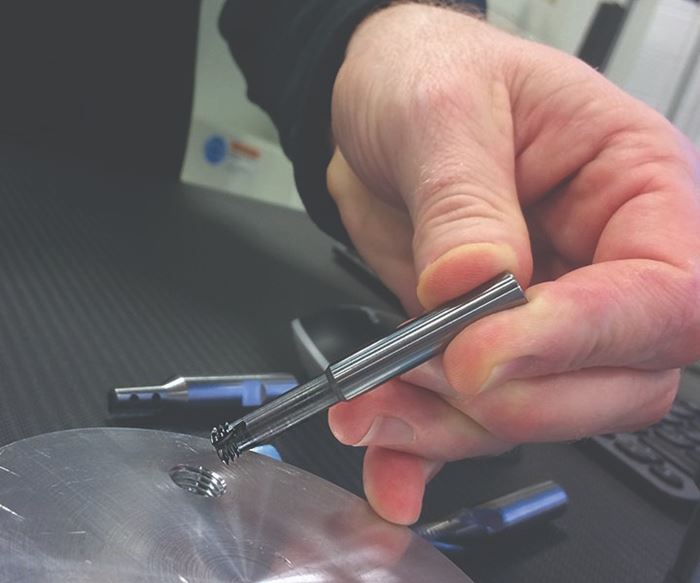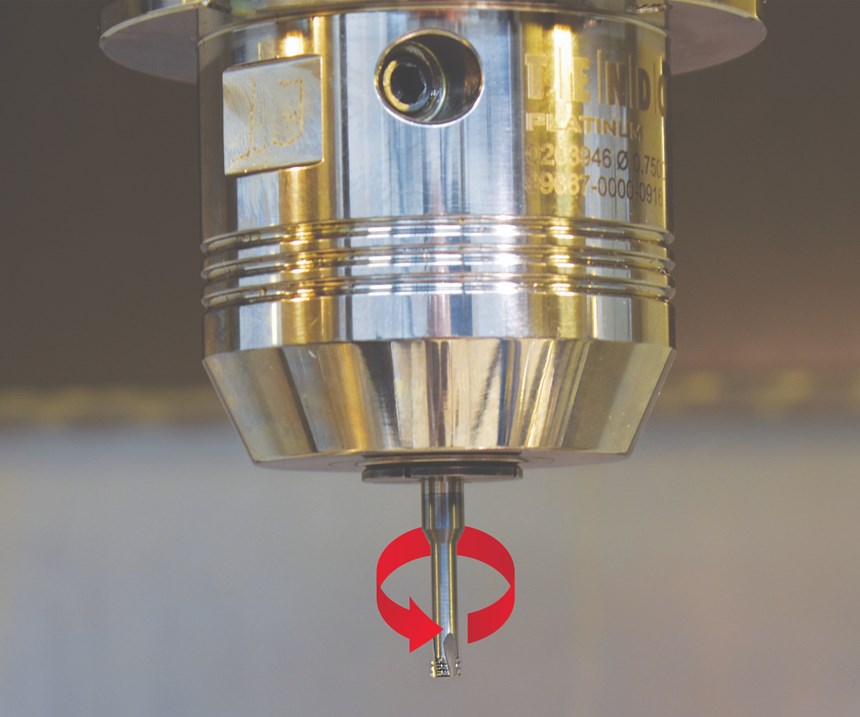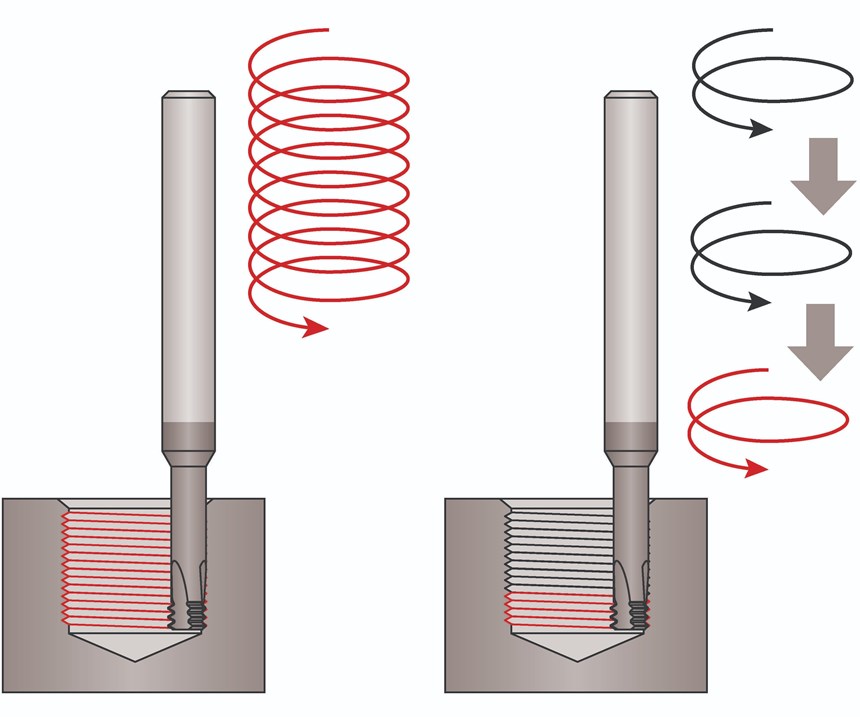Share




Thread milling is becoming more popular for a few reasons, says Jamie Rosenberger, threading tool product manager for Allied Machine and Engineering, manufacturer of holemaking and finishing tools. For one, she says, most new CNC machine tools now offer helical interpolation as a standard feature. (This simultaneous XYZ motion of a spinning thread mill into a part’s hole is required to enable the tool, which has a body diameter that is only a fraction of the hole diameter, to cut the threads.) Therefore, new machinists and programmers who have “cut their teeth” on this type of newer machine tool technology seemingly are more open to considering thread milling as a viable alternative to traditional tapping operations.
In addition, Ms. Rosenberger says thread milling is particularly well-suited for challenging, expensive materials, such as tool steel, stainless steel and high-temperature alloys. In fact, Allied Machine and Engineering’s new AccuThread T3 line of thread mills was designed specifically for these applications.
She explains that during tapping operations, the tap is completely engaged with the workpiece, which results in a good bit of heat generation because the tap’s cutting edges do not get a chance to cool down and coolant has a tough time reaching them. This is particularly problematic when tapping high-temperature alloys, commonly used for aerospace and oil/gas applications, because those materials resist heat rather than absorb it. As a result, all the heat generated during tapping is directed into the tap. This, combined with the high tool pressure resulting from multiple teeth being engaged with the material, can cause the tap to wear prematurely or even break off in the hole. The latter scenario might require time-consuming rework or cause the workpiece to be scrapped, which can be costly given that threading is typically one of the final machining operations performed on a part. These considerations are what make thread milling more attractive to some shops, especially those threading expensive workpiece materials, even though thread mills are more expensive than taps.
That said, it also can be challenging to machine threads in high-temperature and hardened materials using conventional thread-milling tools that machine a complete thread in one 360-degree helical movement (for example, a thread mill that has a sufficient number of cutting edges to mill the entire thread profile into a 0.75-inch-deep hole in one helical rotation). The high cutting pressure generated because all cutting edges are simultaneously engaged with the material can cause tool deflection and poor thread finish.
Conversely, Allied Machine and Engineering’s AccuThread T3 solid carbide thread mill with proprietary, multi-layer AM210 PVD coating cuts essentially one thread at a time in a continuous helical motion into a hole, which minimizes tool pressure and the risk of deflection. Although these tools have three teeth, the first performs the bulk of the thread-cutting action and the other two essentially clean the threads it creates. Therefore, there is little cutting pressure on the tool, so deflection typically is not problematic. In addition, during thread milling, the cutting edges have a chance to cool, because they are not constantly in the cut and it is easier for flood coolant to reach them.
What is also advantageous about the AccuThread T3 is that the tool is spun counterclockwise to enable it to perform climb milling as it is moved helically in a clockwise motion down into a hole when creating a right-handed thread. With climb milling, a tool’s cutting edge creates a “thick-to-thin” chip. That is, it forms the thickest part of the chip when it engages with the material and creates the thinner portion of the chip when it exits the cut. This generates less deflection than conventional milling (in which the tool effectively rubs on the material as it engages to create a “thin-to-thick” chip) and results in more effective chip evacuation to minimize chip re-cutting.
Thread-Milling Tips
Given the benefits that thread milling offers, Ms. Rosenberger says Allied Machine and Engineering still gets questions about how best to leverage this technology. Here, she provides a few tips for shops that are considering thread milling:
• As opposed to tapping, thread milling can provide better hole quality while minimizing the risk of scrapping parts, which is especially important when parts are large and expensive. However, it is not the best threading solution for all applications. Tapping is still typically preferred when producing threads that have length-to-diameter ratios of more than 3:1.
• Think of thread milling like most other machining practices. The more stock to be removed or the more challenging the material, the more passes that may be required. For example, coarse thread pitches might require multiple passes.
• Climb milling is always preferred to conventional milling due to reduced tool deflection and less generated heat.
• Always use cutter compensation when thread milling. This enables you to control the precise diameter of the thread without risking scrapping the part due to creating a thread diameter that is too large.
• Always use rigid toolholders. During cutting, thread mills experience radial side pressure and should be securely clamped in toolholders such as power milling chucks, hydraulic chucks, shrink-fit holders or end-mill holders. ER collets should not be used for thread milling.
• Don’t spend time writing your own thread-milling routines. Many software packages are available from thread-mill manufacturers, such as Allied Machine and Engineering’s InstaCode, to save you time by providing the code to you.
Related Content
Form Tapping Improves Tool Life, Costs
Moving from cut tapping to form tapping for a notable application cut tooling costs at Siemens Energy and increased tool life a hundredfold.
Read MoreThe Future of High Feed Milling in Modern Manufacturing
Achieve higher metal removal rates and enhanced predictability with ISCAR’s advanced high-feed milling tools — optimized for today’s competitive global market.
Read MoreFive Common Mistakes Shops Make with ER Collets (And How to Prevent Them)
Collets play a crucial role in the machining process, so proper tool assembly and maintenance is important. Here are five potential pitfalls to avoid when using ER collets.
Read MoreParts and Programs: Setup for Success
Tips for program and work setups that can simplify adjustments and troubleshooting.
Read MoreRead Next
5 Rules of Thumb for Buying CNC Machine Tools
Use these tips to carefully plan your machine tool purchases and to avoid regretting your decision later.
Read MoreSetting Up the Building Blocks for a Digital Factory
Woodward Inc. spent over a year developing an API to connect machines to its digital factory. Caron Engineering’s MiConnect has cut most of this process while also granting the shop greater access to machine information.
Read MoreBuilding Out a Foundation for Student Machinists
Autodesk and Haas have teamed up to produce an introductory course for students that covers the basics of CAD, CAM and CNC while providing them with a portfolio part.
Read More
























.jpg;maxWidth=300;quality=90)










